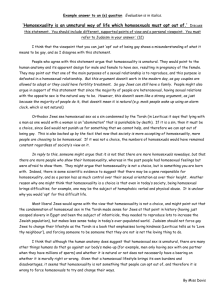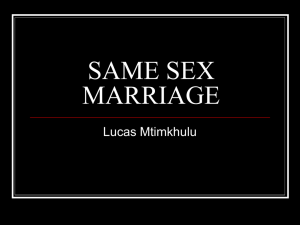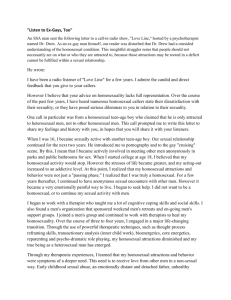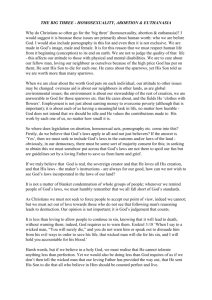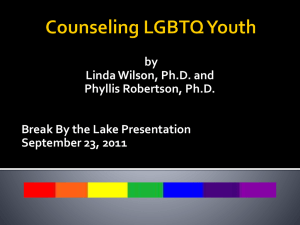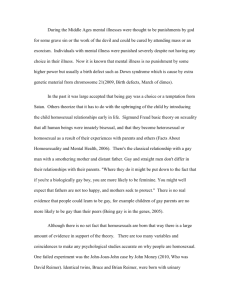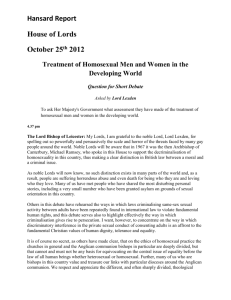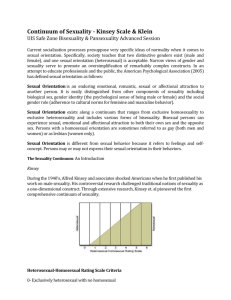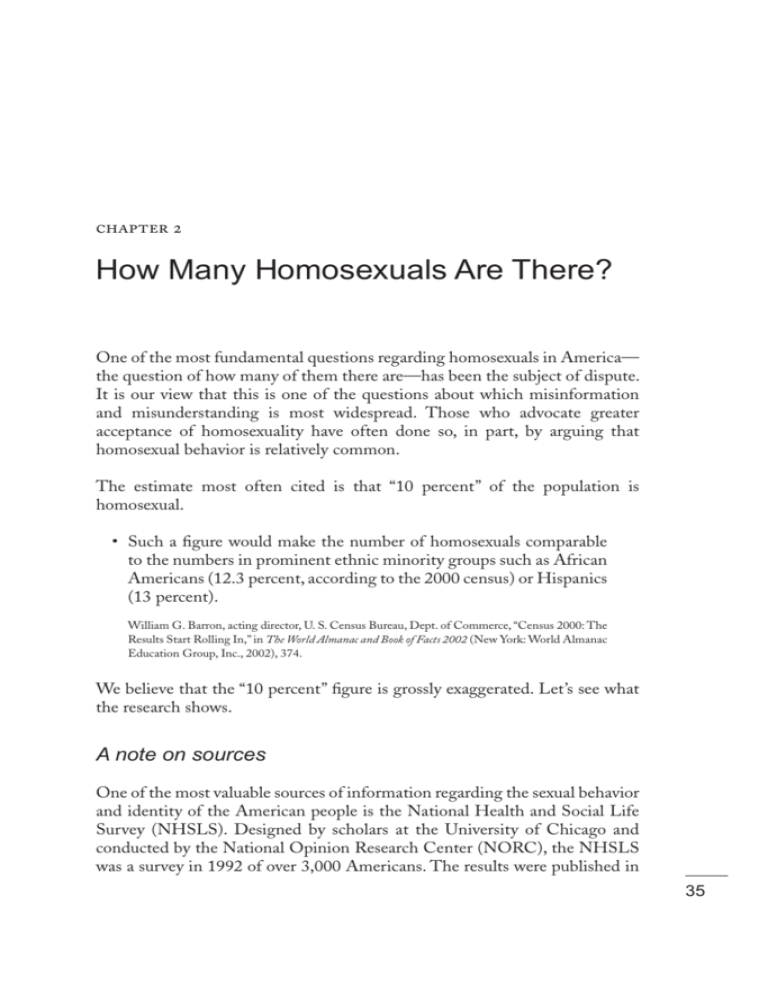
How Many Homosexuals Are There?
One of the most fundamental questions regarding homosexuals in America—
the question of how many of them there are—has been the subject of dispute.
It is our view that this is one of the questions about which misinformation
and misunderstanding is most widespread. Those who advocate greater
acceptance of homosexuality have often done so, in part, by arguing that
homosexual behavior is relatively common.
The estimate most often cited is that “10 percent” of the population is
homosexual.
• Such a figure would make the number of homosexuals comparable
to the numbers in prominent ethnic minority groups such as African
Americans (12.3 percent, according to the 2000 census) or Hispanics
(13 percent).
William G. Barron, acting director, U. S. Census Bureau, Dept. of Commerce, “Census 2000: The
Results Start Rolling In,” in The World Almanac and Book of Facts 2002 (New York: World Almanac
Education Group, Inc., 2002), 374.
We believe that the “10 percent” figure is grossly exaggerated. Let’s see what
the research shows.
A note on sources
One of the most valuable sources of information regarding the sexual behavior
and identity of the American people is the National Health and Social Life
Survey (NHSLS). Designed by scholars at the University of Chicago and
conducted by the National Opinion Research Center (NORC), the NHSLS
was a survey in 1992 of over 3,000 Americans. The results were published in
35
1994 in two separate volumes, one more scholarly and one written at a more
popular level. The scholarly version was:
Edward O. Laumann, John H. Gagnon, Robert T. Michael, and Stuart Michaels, The Social Organization of Sexuality: Sexual Practices in the United States (Chicago: The University of Chicago
Press, 1994).
The more popular version was:
Robert T. Michael, John H. Gagnon, Edward O. Laumann, and Gina Kolata, Sex in America: A
Definitive Survey (Boston: Little, Brown and Co., 1994).
Both works are cited at various times in this chapter, but the reader should be
aware that both are describing the same data set. Because of this, and because
the authors of both works are mostly the same, we have sometimes cited these
works by title rather than by author.
Is “10 Percent” of the Population Homosexual?
The oft-repeated assertion that “10 percent” of the population is homosexual
has been promoted by homosexual activists:
• Edward O. Laumann, et al., writing in The Social Organization of
Sexuality: Sexual Practices in the United States, report that this claim
has been used by homosexual activists to promote gay rights: “In
fact, Bruce Voeller (1990) claims to have originated the 10 percent
estimate as part of the modern gay-rights movement’s campaign in
the late 1970s to convince politicians and the public that ‘We [gays
and lesbians] Are Everywhere.’ At the time, Voeller was the chair of
the National Gay Task Force.”
Edward O. Laumann, John H. Gagnon, Robert T. Michael, and Stuart Michaels, The Social Organization of Sexuality: Sexual Practices in the United States (Chicago: The University of Chicago
Press, 1994), 289, footnote 7; citing Bruce Voeller, “Some Uses and Abuses of the Kinsey Scale,” in
Homosexuality-Heterosexuality: Concepts of Sexual Orientation, ed. David P. McWhirter, Stephanie
A. Saunders and June Machover Reinisch (New York: Oxford University Press, 1990).
• Homosexual activist Bruce Voeller has also written that “after years
of our educating those who inform the public and make its laws, the
concept that 10 percent of the population is gay has become a generally accepted ‘fact.’ While some reminding always seems necessary,
the 10 percent figure is regularly utilized by scholars, by the press,
and in government statistics. As with so many other pieces of knowledge (and myth), repeated telling made it so…”
36
Voeller, “Some Uses and Abuses of the Kinsey Scale,” 33–36.
• The “myth” of the 10 percent figure was uncritically accepted by
many, as reported by Newsweek: “For years, the gay-rights movement has sought safety in numbers. Its leaders have long claimed
that homosexuals constitute 10 percent of the American population.
They cited Alfred Kinsey, who interviewed thousands of men and
women for landmark studies on human sexuality in the 1940s and
1950s.…Policymakers and the press (including Newsweek) adopted
the estimate—despite protests from skeptical conservatives—citing
it time and again.”
Patrick Rogers, “How Many Gays Are There?” Newsweek 15 (February 1993): 46.
The origin of the “10 percent” claim
The 10 percent claim is said to have originated from the infamous Indiana
University sex researcher Alfred Kinsey (d. 1956). However, Kinsey’s
methodology has been challenged as unscientific and unreliable.
• An analysis of Kinsey’s data by Milton Diamond in Archives of Sexual
Behavior finds that his interview subjects were unrepresentative of
the U.S. population as a whole. According to Diamond, Kinsey’s
fellow researchers admitted to him that “the original Kinsey studies
had many respondents associated with known gay groups. This too
biased their sample. None of the randomized studies indicated they
culled their samples of individuals of known gay organizations nor of
those with histories of incarceration.”
Milton Diamond, Ph.D., “Homosexuality and Bisexuality in Different Populations,” Archives of
Sexual Behavior 22 (1993): 298–99.
• The book Sex in America puts it this way: “Kinsey almost certainly
included people who were more sexually active and more willing to
discuss their sex lives. He also made it more likely that he would find
homosexuals by recruiting volunteers in prisons and reform schools
and by asking homosexuals who were part of social networks in large
cities to bring in their friends and acquaintances to be part of his
study.”
Robert T. Michael, et al., “Sex in America,” 174.
• The Social Organization of Sexuality elaborates, saying of Kinsey’s
sampling techniques, “These devices would all tend to bias Kinsey’s
results toward higher estimates of homosexuality (and other rarer
sexual practices) than those that he would have obtained using prob-
37
ability sampling.” It notes that “there is no statistically sound way to
generalize from his sample to a population.” As a result, “Kinsey’s
figures are much higher than those found in all the recent population
surveys, including ours.”
Edward O. Laumann, et al., “The Social Organization of Sexuality,” 289.
• An article in the journal Science declared, “Even 40 years ago, Kinsey’s
data were regarded as unsuitable” for making estimates “of the size
of the population of men who have sex with men.” It added, “Since
the Kinsey sample was not a probability sample, the data do not
allow estimation of the characteristics of the national populations
with knowable margins of error. It is this point that is made most
trenchantly in the major statistical reviews of Kinsey’s research.”
Robert E. Fay, Charles F. Turner, Albert D. Klassen, John H. Gagnon, “Prevalence and Patterns of
Same-Gender Sexual Contact Among Men,” Science 243, Issue 4889 (20 January 1989): 338.
• Even homosexual advocacy research publications have questioned
Kinsey’s methodology. The Journal of Homosexuality points out,
“Although people often use Kinsey’s research to assert that approximately 10 percent of the population is gay, researchers have noted
that there are several problems with this statistic. First, Kinsey did
not use probability sampling methods to construct his sample of the
population. Therefore, it is fallacious to generalize from his biased
sample to the larger society.…[T]he 10 percent estimate provided
in Kinsey’s study of men is derived from Kinsey’s study of white
men and does not, therefore, address the question of homosexuality
(however defined) among women and minorities.”
Matthew V. Pruitt, “Size Matters: A Comparison of Anti- and Pro-Gay Organizations’ Estimates
of the Size of the Gay Population,” Journal of Homosexuality 42 (2002):22.
• The Gay and Lesbian Review Worldwide reiterates the weaknesses of
the Kinsey research: “Most people have concluded that 10 percent is
probably an overestimate. The major criticism is that Kinsey’s sample
was skewed to over-sample for the homosexually inclined—for
example, it included a large number of male prisoners.”
Richard Schneider, Jr., “‘The People Gay’ and the 10 Percent Debate,” Gay and Lesbian Review
Worldwide 7(2): 4–6 (Spring 2000), Academic Search Premier AN 2990702, ISSN 1532-1118.
38
• The final word on the “10 percent” estimate may be summarized in
a Newsweek report on the issue: “The 10 percent—which represents
adult males who said they were predominantly homosexual for at
least three years—suggests that a significant part of Kinsey’s sample
was gay, but nothing more. ‘It’s just not a real number,’ says University of Washington sociologist Pepper Schwartz.”
Rogers, “How Many Gays Are There?” 46.
Kinsey did not claim that 10 percent of the population is
homosexual
It is worth pointing out that even with his skewed research, Kinsey did not
conclude that 10 percent of Americans are homosexual.
• The Gay and Lesbian Review Worldwide admits that “Kinsey’s ‘10
percent’ category was defined very broadly, and certainly included
lots of people who wouldn’t qualify as out gay men or lesbians by
today’s definition.”
Richard Schneider, Jr., “‘The People Gay’ and the 10 Percent Debate,” Gay and Lesbian Review
Worldwide 7 (Spring 2000), Academic Search Premier AN 2990702, ISSN 1532-1118.
• Michael, et al., elaborate, stating that Kinsey’s “10 percent” figure
was limited to those who claimed to have “had only homosexual
experiences for any three-year period between ages sixteen and fiftyfive (this is probably where the popularized 10 percent figure came
from).…In fact, a reanalysis of the Kinsey data for college men only,
showed that the proportion of men who said they had had exclusively homosexual experiences since age eighteen was 3 percent…”
John H. Gagnon and William Simon, Sexual Conduct (Chicago: Aldine Press, 1973), cited in
Michael, et al., Sex in America, 173.
Recent research does not support the “10 percent” claim
• Newsweek reports that “new evidence suggests that ideology, not
sound science, has perpetuated a 1-in-10 myth. In the nearly half
century since Kinsey, no survey has come close to duplicating his
findings.”
Patrick Rogers, “How Many Gays Are There?” Newsweek 15 (February 1993): 46.
• A review of studies from the U.S. and abroad published in the
Archives of Sexual Behavior concludes: “No study finds any figure
reaching 10 percent for all respondents experiences with homosexual
39
and bisexual activity combined.…All these studies taken together
indicate that bisexuality, and indeed homosexuality, are less common
than previously considered.”
Diamond, “Homosexuality in Different Populations,” 303.
• The review recommends that “the oft-used 10 percent figure needs
downward revision in light of the more reliable and valid data from
the scientifically randomized samples reported here.”
Ibid., 305.
• Laumann, et al., concur: “[A]ll the recent population-based surveys
of sexual behavior, including this one, have found rates that are much
lower than 10 percent.”
Laumann, et al., The Social Organization of Sexuality, 286.
The political agenda behind promoting the 10 percent
figure
A study in the homosexual advocacy research publication Journal of
Homosexuality outline the reasons for promoting the 10 percent figure:
• “First, the size of the gay population has potential political ramifications.…More gay people, quite straightforwardly, means more
political clout.…For politicians of either ilk [“pro-gay” or “anti-gay”]
the size of the gay vote is an important political factor.…Second,
business and corporate decisions may be directly or indirectly influenced by estimates of the size of the gay community. For example,
corporations have advertised in gay magazines, provided gay-pride
color beer lights to gay bars, and shown same-sex couples in
advertisements (e.g., IKEA, Bud Light)…Third, many gay groups
actively seek to make the transition to self-acceptance easier for
those people who are coming to terms with the fact that they have a
same-sex sexual orientation.…The message that most clearly links
to the size of the gay population is ‘You are not alone.’ Clearly, one is
less alone is 10 percent of the population is gay than if 1–3 percent
of the population is gay.”
Matthew V. Pruitt, “Size Matters,” 26–27.
• Michael, et al., agree: “Many gay groups would like the number to be
40
large, so they can argue that homosexuals are a force to be reckoned
with, that any politician who avoids or alienates gay voters does so
at his or her peril. They have promoted the phrase “one in ten”—one
American in ten is gay or lesbian, they assert.”
Robert T. Michael, John H. Gagnon, Edward O. Laumann, and Gina Kolata, Sex in America: A
Definitive Survey (Boston: Little, Brown and Co., 1994), 172.
What Percentage of the Population
is Homosexual?
The difficulty of claiming that a certain percentage of the population is
unalterably “gay” is explained in the book Sex in America:
• “First, people often change their sexual behavior during their lifetimes, making it impossible to state that a particular set of behaviors
defines a person as gay.…Often implicit in a [single fixed] figure…is
the assumption that homosexuality is a characteristic like green eyes
that is part of a person’s identity and never changes.”
• “A second reason is that there is no one set of sexual desires or
self-identification that uniquely defines homosexuality. Is it sexual
desire for a person of the same gender, it is thinking of yourself as a
homosexual, or is it some combination of these behaviors that makes
a person a homosexual?”
• “A third reason is that homosexual behavior is not easily measured.”
Michael, et al., Sex in America, 172
• The Social Organization of Sexuality notes that “homosexuality is a
complex, multidimensional phenomenon whose salient features are
related to one another in highly contingent and diverse ways.”
Laumann, et al., The Social Organization of Sexuality, 320.
• Similarly, Diamond asks: “Would individuals who had 1 or 2 homosexual experiences and 100 heterosexual ones be rated the same
as someone who had had 1 and 10?…Do we include or exclude
41
adolescent experimentation or prison experiences that are never
repeated? How should one distinguish between self-identification and labeling by professionals? Should we reserve the terms
‘homosexual,’ ‘bisexual,’ or ‘heterosexual’ for an individual’s activities
or fantasies or both…?”
Diamond, “Homosexuality and Bisexuality in Different Populations,” 297.
Measuring the Homosexual Population
Laumann, et al., describe how homosexuality is measured: “For the purpose
of this analysis, we have divided the questions that relate to homosexual
experiences and feelings into three basic dimensions: behavior, desire, and
identity.”
Laumann, et al., The Social Organization of Sexuality, 292–93.
The homosexual population measured by “self-reporting”
or “identity”
One means of ascertaining the percentage of homosexuals in a population is
by counting those who describe themselves as homosexual. According to this
measure, homosexuals comprise a very low percentage of the population:
• Sex in America: A Definitive Survey reports: “We asked respondents whether they consider themselves heterosexual, homosexual,
bisexual, or something else. This question elicited the lowest rates of
homosexuality. About 1.4 percent of the women said they thought
of themselves as homosexual or bisexual and about 2.8 percent of the
men identified themselves in this way.…No matter how we define
homosexuality, we come up with small percentages of people who
are currently gay or lesbian.”
Michael, et al., Sex in America, 176–77.
• Even the leading homosexual activist groups in the country conceded the validity of these same estimates, in a little-noticed footnote to the brief they submitted to the U.S. Supreme Court in the
Lawrence v. Texas sodomy case in 2003: “The most widely accepted
study of sexual practices in the United States is the National Health
42
and Social Life Survey (NHSLS). The NHSLS found that 2.8
percent of the male, and 1.4 percent of the female, population
identify themselves as gay, lesbian, or bisexual. See Laumann et al.,
The Social Organization of Sex: Sexual Practices in the United States
(1994).”
Lawrence v. Texas, Docket No. 02-102 (U.S. Supreme Court), brief of amici curiae Human Rights
Campaign et al., 16 January 2003, 16 (footnote 42).
MEN
Bisexual 0.8%Other 0.3%
Homosexual 2%
WOMEN
Bisexual 0.5%
Other 0.1%
Heterosexual 96.9%
Homosexual 0.9%
Heterosexual
Chart: Sexual Orientation of Americans (by Self-Identification)
Source: Edward O. Laumann, John H. Gagnon, Robert T. Michael, and Stuart Michaels, The
Social Organization of Sexuality: Sexual Practices in the United States (Chicago: The University of
Chicago Press, 1994), 311, Table 8.3B.
The percentage of young people self-identifying as
homosexual
• A study in Pediatrics of 4,159 high school students in Massachusetts found similarly low percentages of youth who self-identify as
homosexual: “Sexual orientation was determined by the following
question: ‘Which of the following best describes you?’ A total of
104 students self-identified as gay, lesbian, or bisexual (GLB), representing 2.5 percent of the overall population. Of GLB youth, 66.7
percent were male…”
Robert Garofalo, MD; R. Cameron Wolf, MS; Shari Kessel, ScB; Judith Palfrey, MD; and Robert
H. DuRant, PhD; “The Association Between Health Risk Behaviors and Sexual Orientation
Among a School-based Sample of Adolescents,” Pediatrics 101 (May 1998): 895–902.
The homosexual population measured by behavior
The percentage of youths who actually engage in homosexual
behavior:
43
• Family Planning Perspectives analyzed the National Longitudinal
Study of Adolescent Health, which surveyed 18,924 adolescents
from 132 schools and found an extremely low level of homosexual
behavior. The report said, “The final data set for our analysis
included 17,266 heterosexual relationships, which were reported by
8,024 adolescents.” By comparison, the survey respondents “reported
only 20 homosexual relationships. These relationships were removed
from the data file because they were two few to include in our analyses.” This means that 0.1 percent—about one in a thousand—of the
adolescent “sexual relationships” identified by the researchers were
homosexual in nature.
Kathleen Ford, Woosung Sohn, and James Lepkowski, “Characteristics of Adolescents’ Sexual
Partners and Their Association with Use of Condoms and Other Contraceptive Methods,” Family
Planning Perspectives 33 (May/June 2001): 101.
With regard to the population as a whole, researchers have used various
measures to ascertain the percentages of those who have engaged in
homosexual activity, including:
Those engaging in homosexual behavior during the previous
year:
• The Archives of Sexual Behavior study reports a 1988 National
Opinion Research Center (NORC) random household study, which
found that “only 2.4 percent of their males indicated same-sex
behavior within the preceding year.” A 1991 NORC study “found
less than 2 percent of sexually active adult males and females…
reported exclusive homosexual or bisexual activity the preceding
year. After adjusting for ‘uncertain’ or nonresponding cases Smith
reported only 0.7 percent were exclusively homosexual since the age
of 18…”
Diamond, “Homosexuality and Bisexuality in Different Populations,” 299.
• In measuring homosexual behavior, Laumann, et al., conclude: “The
rates for women are lower than the rates for men, varying from 1.3
percent of the sexually active women in the past year reporting at
least one female partner to 4.1 percent reporting any female partners
since turning eighteen. The rates for men vary from 2.7 percent in
the past year to 4.9 percent with any male partners since age eighteen.”
44
Laumann, et al., The Social Organization of Sexuality, 294.
During the previous 10 years:
• A nationally representative study of the sexual behavior of men aged
20–39 reported in Family Planning Perspectives found that only 2.3
percent of “sexually active men aged 20–39 have had any samegender sexual activity during the last 10 years, and only 1 percent
reported being exclusively homosexual during this interval.”
John O. G. Billy, Koray Tanfer, William R. Grady and Daniel H. Klepinger, “The Sexual Behavior
of Men in the United States,” Family Planning Perspectives 25 (March/April 1993): 52, 59.
Since puberty:
• The Archives of Sexual Behavior reported, “If we use the largest figures available…within each study, we find a mean of 5.5 percent and
a median of 5.3 percent represents the population of males having
engaged in same-sex behavior. Female figures are even smaller: mean
2.5 percent and median 3.0 percent. Our round numbers would thus
be 5–6 percent for males and 2–3 percent for females.”
Diamond, “Homosexuality and Bisexuality in Different Populations,” 306.
• Laumann, et al., report: “Over 4 percent of the women [4.3 percent]
and 9 percent of the men [9.1 percent] reported having engaged
in at least one of these sexual practices [“oral sex” or “anything else
sexual”] with a person of their own gender since puberty.”
Laumann, et al., The Social Organization of Sexuality, 294–96.
Since age 18:
• The Demography study reported nearly identical results when sexual
behavior is measured, finding that while 4.7 percent of men had at
least one same-sex experience since age 18, “only 2.5 percent of men
have engaged in exclusively same-sex sex over the year preceding
the survey. Similarly, 3.5 percent of women have had at least one
same-sex sexual experience, but only 1.4 percent have had exclusively
same-sex sex over the year preceding the survey.”
Black, et al., “Demographics of the Gay and Lesbian Population in the United States,” 141.
Those claiming to have been exclusively involved in homosexual
or lesbian behavior:
45
• Laumann, et al., found that “under 1 percent of all men (0.6 percent)
have had sex only with other boys or men and never with a female
partner. For women, the proportion is even smaller. About 5 percent of the women who have had female partners since puberty have
never had sex with a male partner. This means that, overall, only 0.2
percent of all women had had sex only with women.”
Laumann, et al., The Social Organization of Sexuality, 311–12.
• Billy, et al., report that a nationally representative study of the sexual
behavior of men aged 20 to 39 in the United States shows that
during the last ten years, “Approximately 1 percent [actually, 1.1
percent] of the men reported having had exclusively homosexual
activity.”
Billy, et al., “The Sexual Behavior of Men in the United States,” 52, 59.
• The Demography study concludes: “Suppose we adopt the reasonably narrow definition of gay and lesbian to be individuals who have
engaged in exclusively same-sex sex over the last year, [then] 2.5
percent of men are gay and 1.4 percent of women are lesbian.”
Black, et al., “Demographics of the Gay and Lesbian Population in the United States,” 147.
Those who engage in homosexual behavior (often for a temporary
period of time) due to circumstances:
Finally, it is worth pointing out that some individuals, who are not
homosexually-inclined, may be temporarily involved with homosexuality for
various reasons, including curiosity or coercion:
• Men who engage in homosexuality only during their youth constitute a significant percentage of those who report homosexual
behavior. Laumann, et al., found that those “who report samegender sex only before they turn eighteen, not afterward, constitute
42 percent of the total number of men who report ever having a
same-gender experience.”
Laumann, et al., The Social Organization of Sexuality, 296.
46
• Gagnon and Simon also report that for over half of those men who
had at least one homosexual experience, “this experience was before
the age of fifteen and not after.”
Gagnon and Simon, Sexual Conduct, pp. 131-32; cited in Laumann, et al., The Social Organization
of Sexuality, 289, footnote 8.
• Fay et al., reporting in Science magazine, reached similar conclusions
after analyzing data from a 1970 survey of American men age 21
or older. Forty-six percent of the men who reported “any homosexual experience” in their lifetimes reported that it occurred only
prior to the age of 15 and not since. In addition, 24 percent of those
reporting any lifetime homosexual experience reported they had had
only one such experience. In fact, the number who reported they
had had only one homosexual experience in their lifetime and that
it had occurred before age 15 was three times as high as the number
who had had homosexual experiences at age 20 or older and had
them “fairly often.”
Calculated from Tables 2 and 3 in Robert E. Fay, Charles F. Turner, Albert D. Klassen, John H.
Gagnon, “Prevalence and Patterns of Same-Gender Sexual Contact among Men, Science, New
Series, Vol. 243, Issue 4889 (20 January 1989): 341–42.
• Incarceration is another cause of “temporary” homosexual behavior.
Noting that “many male respondents in the Kinsey surveys were
prison inmates or had jail experiences,” the Archives of Sexual
Behavior study concludes: “Necessity might also force such behavior.
In addition, any individual may exhibit heterosexual, homosexual,
or bisexual behaviors for many reasons that have nothing to do with
sexual arousal or interest. An individual, for example, may engage in
homosexual or heterosexual activities for friendship, due to coercion
or curiosity, or a host of other reasons…”
Diamond, “Homosexuality and Bisexuality in Different Populations,” 298.
• Similarly, The Social Organization of Sexuality reports: “Some engage
in sex with same-gender partners without any erotic or psychological
desire because they have been forced or enticed into doing so. A
classic example is sex in prison. [Being d]eprived of the opportunity
to have sex with opposite-gender partners gives rise to same-gender
sex, by volition or as the result of force.”
Laumann, et al., The Social Organization of Sexuality, 291.
• Sex in America refers to the temporary nature of much homosexual
activity: “Far more women and men experimented with homosexuality than currently identify themselves as lesbians or gays. It seems
likely that many try it and then go back to being heterosexuals,
47
neither desiring others of their own gender nor finding the idea of
homosexual sex very appealing.”
Michael, et al., Sex in America, 182.
The homosexual population as measured by those who exhibit all
three aspects of same-gender sexuality: behavior, desire, and identity
• When all three possible aspects are taken together, we arrive at a
low percentage of the population who are identified as homosexual.
Laumann, et al., isolated “a core group (about 2.4 percent of the
total men and about 1.3 percent of the total women) in our survey
who define themselves as homosexual or bisexual, have same-gender
partners, and express homosexual desires.…”
Laumann, et al, The Social Organization of Sexuality, 300–301.
The Myth of “Exclusive” Homosexuality
Contrary to the common perception of homosexuals as those who are
exclusively attracted to the same-sex, the research indicates that many
homosexuals have also engaged in sexual relations with those of the opposite
sex. This illustrates again the difficulty of precisely defining who should
even be classified as “a homosexual.” The evidence suggests that there is a
substantial (though still quite small) population of people who experiment
with homosexual behavior at some time in their lives. However, the percentage
of people who are exclusively homosexual in their behavior throughout their
lifetimes is extremely small indeed.
48
• The Demography study found that while “only a small fraction of
heterosexual men and women ever have sex with a member of the
same sex,” homosexuals do not similarly shun heterosexual sex: “Gay
men, however, typically have had sex with a woman, and lesbian
women typically have had sex with a man, at some time since age
18.” In particular, “among women who had at least one female sex
partner since age 18, only 28 percent have been involved, over the
past year, in exclusively same-sex sexual relationships. Similarly, only
42 percent of men who have had a male sexual partner since age 18
have had exclusively same-sex sex over the year before the survey.”
Black, et al., “Demographics of the Gay and Lesbian Population in the United States,” 141, 144.
• Laumann, et al., report that many homosexuals also have sexual
experiences with and interest in people of the opposite gender as
well. Their study found that in the past five years, about half of
the men reporting same-sex sexual behavior “had both male and
female partners in this time period. The women are more likely than
the men to have had sex with both men and women [rather than
with] only same-gender partners. Almost two-thirds of the women
reporting a female partner in the past five years also report a male
partner. The proportion of the men with male partners since age
eighteen who report having had only male partners declines to about
20 percent of the total. For women, the comparable figure is about
10 percent.”
Laumann, et al., The Social Organization of Sexuality, 311.
• As for lesbians, a survey of 6,935 women in the U.S. reported in the
Archives of Internal Medicine found that “77.3 percent reported ever
having had a male sexual partner, [and] 70.5 percent had engaged in
vaginal intercourse at least once…”
Allison L. Diamant, Mark A. Schuster, Kimberly McGuigan, Janet Lever, “Lesbians’ Sexual
History with Men: Implications for Taking a Sexual History,” Archives of Internal Medicine 159
(December 1999): 2,730–2,731.
• In fact, when the lifetime figures for any homosexual activity (“Any
sex” in Chart 1 below) are compared with the lifetime figures for
exclusively homosexual activity (“Since puberty” in Chart 2 below),
we find that only about one in every 15 men with homosexual experience has been exclusively homosexual in behavior, while only about
one in every 21 women with homosexual experience has been exclusively homosexual.
10
Chart 1: Percentage of People Who Have Engaged
in Any Homosexual Activity in Given Time Period
9
8
Percent
Last
year
2
Last years
5
7
6
Since age
5
Any age
4
3
2
"Any sex"
1
1
0
3
Men
Women
1 The figures for these time periods are based on questions asking when they “had sex with a
[person of the same sex].”
49
2 The figures for this category are based on a different question asking if the respondent had
engaged in specific sex acts or “ever done anything else sexual” with a person of the same sex
(Laumann et al., pp. 294, 674, 676).
3 Laumann et al. give a figure of 3.8 percent for this measure (p. 294 and Figure 8.1 on p. 295).
However, this is logically inconsistent with the figure given in the previous category; it is impossible for the number who have had such sexual relations at “any age” to be lower than the number
who have had such relations just “since age 18.” Since Laumann et al. give no explanation for this
discrepancy, we have omitted this lower figure from the chart.
Edward O. Laumann, John H. Gagnon, Robert T. Michael, and Stuart Michaels, The Social Organization of Sexuality: Sexual Practices in the United States (Chicago: The University of Chicago
Press, 1994), 294–96.
Chart 2: Percentage of People Who Have Engaged in Exclusively
Homosexual (and no Heterosexual) Activity in Given Time Period
5
4.5
Last
year
Percent
4
3.5
Last years
5
3
Since age 18
2.5
2
1.5
1
Since Pubert
1
0.5
0
Men
Women
1 The fact that this figure is the same as the “last year” figure may seem anomalous, since one
would expect exclusivity to decline with time. However, it may be explained by the fact that the
percentages are of all respondents, including those who had no sexual activity in the given time
period. Therefore, this figure may include men who have had no sexual relations in the last year,
but have had exclusively homosexual relations during the last 5 years.
Edward O. Laumann, John H. Gagnon, Robert T. Michael, and Stuart Michaels, The Social Organization of Sexuality: Sexual Practices in the United States (Chicago: The University of Chicago
Press, 1994), 310–312.
Homosexuality in Other Cultures
Researchers report similarly low percentages of homosexuals in other nations
and cultures:
Europe:
50
• French and British surveys of sexual behavior reported in Science
found that “homosexuality turns out to be significantly less common
than suggested by Alfred Kinsey’s survey.” Alfred Spira, leader of the
project that surveyed 20,000 French people between the ages of 18
and 69, found the percentage of homosexuals to be “rather low, in
comparison to what I had expected.” The Science report continues:
“His group found that 4.1 percent of men and 2.6 percent of women
said that they’d had homosexual intercourse at least once in their life.
Only 1.1 percent of men and 0.3 percent of women said they’d had
homosexual intercourse in the past 12 months. Those figures should
help lay to rest myths about homosexuality that persist from Kinsey’s
survey…”
Peter Aldhous, “French Venture where U.S. Fears to Tread,” Science 257 ( July 3, 1992):25.
• Similarly, the Archives of Sexual Behavior reports: “Findings from a
British national random study (Wellings et al., 1990) also show low
figures for homosexual activity.…[O]nly 5 percent of men and 1
percent of women reported ever having a homosexual partner.”
Diamond, “Homosexuality and Bisexuality in Different Populations,” 302.
• The Archives of Sexual Behavior also found that a randomly selected
population of Danish women personally interviewed by a female
physician “found only 2 of 625 women [0.3 percent] from 22 to 70
years of age reporting having had a homosexual experience.”
Ibid., 301.
• A survey of sexual behavior by the Dutch National Institute for
Social Sexological Research and Utrecht University found, “In the
preceding 12 months only 3.6 percent of the males and 0.3 percent of the females surveyed had exclusive same-sex contacts and an
additional 1.9 percent of their male sample and 0.5 percent of their
female sample had bisexual activities.”
Ibid., 302.
Non-Western countries:
The Archives of Sexual Behavior study also examined homosexuality in other
cultures and found similar percentages of homosexuals:
• One researcher in the Philippines found six male homosexuals and
51
no lesbians in a village of 729 inhabitants. In addition, in the province of Siaton, with a population of 2,862, “there were 12 male
homosexuals and ‘several’ lesbians.” In another village with a with a
population of approximately 18,000, “there were 70 openly homosexual males and 58 lesbians’ (0.7 percent).”
• The report continues: “Recent research from Thailand by Sittitrai
et al. (1992) reported similarly. Same-sex contact was reported by
3.3 percent of the males interviewed but only 0.2 percent indicated
such behavior was exclusively homosexual. Among females 1.1 percent reported they had same-sex contact and 0.9 percent said it was
exclusively so.”
• A random sample of the population of the Republic of Palau found
that “after the age of 20, homosexual activity was reported by 1.9
percent of the males and 2.8 percent of the females interviewed.
Bisexual activity was reported by 2.8 percent of the males and 0.7
percent of the females.” The study mentions, “In these nonhomophobic societies, Philippines, Thailand and Palau, it is interesting to
note we find reported the lowest rates of same-sex activity.”
• Diamond reports that in the first wide scale survey of China, “2.3
percent of ‘peasants’ and .5 percent of ‘city dwellers’ considered
themselves gay.”
Ibid., 301
What do Americans Believe About the Number of
Homosexuals?
In spite of the overwhelming evidence above, the efforts to convince Americans
that the homosexual population is large have been very effective.
• A survey of the American public conducted by Princeton Survey
Research for the Kaiser Family Foundation found that only 14 percent of the general public correctly identified the size of the homosexual population as 3 percent or less. Seventy-two percent gave an
exaggerated estimate, with at least 38 percent believing that homosexuals are actually more than 10 percent of the population. In fact,
8 percent guessed that over 40 percent of Americans are homosexual.
Ironically, however, the Kaiser survey itself showed that only 2 per52
cent of those surveyed identified themselves as “gay or lesbian” and
only 1 percent as “bisexual.”
The Henry J. Kaiser Family Foundation, Inside-OUT: A Report on the Experiences of Lesbians, Gays
and Bisexuals in America and the Public’s Views on Issues and Policies Related to Sexual Orientation
(November 2001), 5, 16; online at http://www.kff.org/content/2001/3193/LGBToplines.pdf (accessed October 22, 2003).
53

